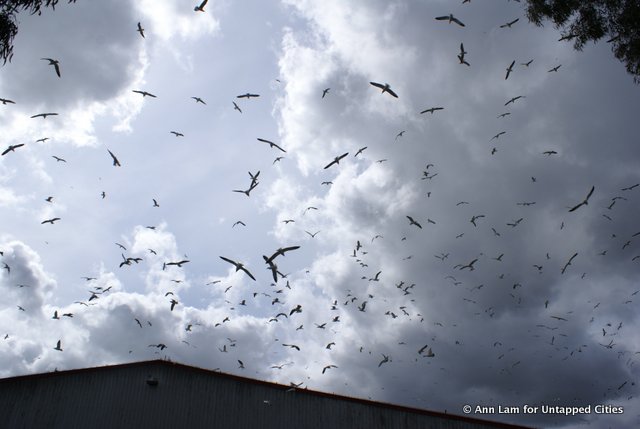I grew up in landlocked Colorado, thousands of miles from the nearest ocean, where seagulls were weirdly common. I thought there was something majestic and coastal about them. It turns out that they weren’t drawn to the Platte River, but to the wrappers and smooshed food bits they could find in dumpsters and parking lots.
Here in San Francisco, we see seagulls in their natural habitat at China Beach or the Albany Bulb, but again, those darn birds have a taste for grit, and they’re also drawn in droves to the San Francisco dump, on the southeastern edge of the city. It’s a problem, and the folks at Recology San Francisco have found a solution.
The gulls love the organic waste at the dump, rich as it is with food scraps from San Francisco’s restaurants and residents, as well as leftovers from the fish markets. Gulls are scavengers, they’ll eat fish bits, amphibians and worms, but they really shouldn’t be eating chicken bones or pizza crusts or pad thai. Feasting dump gulls are also messy, picking up bits of plastic and other trash, spreading it around in nearby neighborhoods, feeding it to their chicks, and dropping it into the San Francisco Bay waters.
However, Indigo Redondo, a licensed falconer, and his small flock of raptors are working diligently to make the dump a less appealing place for the gulls. By taking advantage of the gulls’ hard-wired fears of the birds of prey, Recology San Francisco is able to minimize the problems the gulls can cause without causing actual harm to the gulls or other birds in the area.
 Rosemarie, a Saker falcon, hard at work.
Rosemarie, a Saker falcon, hard at work.
Redondo has five trained birds that he brings to the site on a rotating basis: a Peregrine falcon named Cleo; a Harris hawk named Nina; a Saker falcon named Rosemarie; and two new birds, another Harris and another baby Saker, Maya, who is still being trained. The birds are all captive bred by state-licensed breeders, and only licensed falconers like Redondo can keep them. (All birds of prey are protected species, you can’t just grab one out of the wild and tame it.)
The raptors’ natural instinct is to hunt, so to protect the safety of gulls and other birds, Redondo keeps them well fed and carefully tracks their weight. Since they’re not hungry, they’re not actually hunting the gulls. Instead they fly around the facility a bit, take in the view from the tops of buildings and return to Redondo for treats. But to the gulls, the raptors are flashing danger signs, and the presence of the raptors is enough of a deterrent to keep the gulls away. The idea is similar to graphic health warnings on the sides of a cigarette carton, calorie information at a fast food restaurant, or guard dogs with a scary bark but no bite.
Redondo also has a border collie, Raine. Raine is a registered service dog who started her career as an airport bird control specialist, chasing birds off of runways. Now she hazes seagulls that are idling on the ground at the dump, trying to keep them from settling in.
Falconry is a post-retirement job for Redondo, and he says he works more than he ever did in his career at FedEx. The program is technically bird control or bird abatement; it’s not falconry because Redondo’s birds are not used for hunting. Similar programs are also in effect at the Pebble Beach golf course, Travis Air Force Base, and this year’s French Open.
 Redondo conferring with Rosemarie as she flexes her wings.
Redondo conferring with Rosemarie as she flexes her wings.
It is enormously effective as seen on the one day a week Redondo has off. On those days the droves of gulls return. “There’s such a large food source, when they see I’m not around, they see there is no threat”¦. It’s been going on for generations. We humans have created an easy place for them to eat.”
Before Redondo and his flock arrived, Recology would block off the trash processing area using hanging strips of plastic, and spray grape extract onto the trash, creating a taste that’s foul to gulls. But neither was as effective as the raptors, especially since the grape extract was constantly being buried as the trash was moved around. “This is an eco, green approach to bird control,” Redondo concludes. “We’re not here to do harm to anything, we’re just keeping the birds uncomfortable.”
 Seagulls at the San Francisco Dump. Only the bravest remain.
Seagulls at the San Francisco Dump. Only the bravest remain.
I still think seagulls are pretty birds, even knowing they can be a nuisance. The fact that they have instinctual fears of raptors like Rosemarie is heartening as well. We have created these huge, unnatural food sources, and we have lured them all the way to Colorado, but there is still a bit of wild animal lurking in their little bird brains.
See previous Untapped Cities coverage of Recology SF.
Follow Untapped Cities on Twitter and Facebook! Get in touch with the author @shanthrax815.






